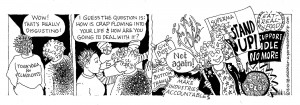Marie Koehler has an awesome alter ego. The Dartmouth-based artist has created a super hero for our times: Superma!.
Superma! (That’s Superman without the ‘n’) is a kick-ass grandmother who tackles pressing environmental issues such as fracking and climate change with the help of her trusty sidekick Dystaf.
Koehler, who has worked as an artist for most of her life, explains to Hello Dartmouth readers the genesis of this quirky character and how graphic artists can make important issues accessible.
Tell us a bit about Superma!
MC: Superma! in its current form is an on-line strip about environmental issues.
Superma!’s sidekick is Dystaf, a talking stick, who can say things Superma! can’t or shouldn’t and who sometimes channels larger minds to bring clarity to a situation.
Superma! also has several friends who appear from time to time, as well as a daughter and grandchild, and lives with a dog. Doggerel, and a cat, Catastrophe.
Where did the idea come from?
MC: I developed Superma! in 1997 when I was working for StreetFeat, Halifax’s monthly newspaper by and for the poor. At that time the strips were about poverty issues – how to get out of poverty, how a person might feel about being in poverty… with a lot of new-age solutions as well.
I admired StreetFeat’s originators – Roberto Menendez and Michael Burke– and I met a lot of wonderful people during that year and stopped being afraid of strangers I might encounter on the street. I learned to see people as their own valuable selves who might be having a hard time.
Doing a comic strip didn’t come naturally to me. I’m not knowledgeable regarding comics in general. I had read comics as a child and thought I understood the medium, but it took a while, with the help of comic friends Graham Pilsworth and Bob Williams, for me to understand how to tell a comic strip story. Learning how to tell a story in this way was very helpful to me when I was telling different kinds of stories in video.
Why did you create this particular character?
MC: Write what you know! Superma! is an aspect of myself. She has some of my weaknesses and strengths. She’s oldish and fattish with a rebellious point of view and a sense of humour that is by times silly or dark.
I thought that by taking these various parts of myself I could contribute to the environmental movement and, if not able to change the world, at least encourage some clear thinking about what we need to do as a society.
Why take on environmental issues?
MC: I was turned on to these issues in 1962, reading Silent Spring by Rachel Carson, at the same time that it seemed that nuclear war was imminent. In the late 1970s, Nova Scotia was planning to allow uranium mining 9 kilometres from my home.It was a very hard and expensive battle for those of us who understood the full consequences of uranium mining – serious damage to groundwater, tailings that would emit radiation for thousands of years, the potential for use in nuclear weapons, and very small local employment in exchange for all that angst – but we eventually achieved a moratorium, which still stands.
Climate change is the single most important issue of our day. If we don’t come to terms with it immediately and change probably everything about the way we live and conduct business and government, we, and most other species on earth will die or be forever and grotesquely changed. Because the oceans have absorbed so much carbon from our activities, they are very close to dying. Because we have allowed fracking in every corner of the world we are experiencing earthquakes where we never before had them. Because we are cutting down trees all over the world, the planet’s lungs are gasping. Because we have allowed genetically modified foods into out food chain and have dumped millions of tons of chemicals onto out soil, people are getting sicker. I could go on….
Why do you think a comic strip is an effective way to share an environmental message?
MC: I made a lot of ‘fine’ art about environmental issues – two installations, dozens of drawings, several paintings… but people spend less than a minute with most works of art. And I’ve always been interested in populist arts – asking questions such as, Is it it possible to create ‘fine’ art and make it available for low income people? probably not. Is it possible to entice people not interested in art to go see it? probably not. So how do you influence people when you are my kind of artist? YouTube? animations? comics? maybe. Maybe I could try a strip.
In theory, comic strips are supposed to be funny and funny is the honey that helps the medicine go down. My work is rarely funny- haha, but I think a lot of people share my sense of, “what?, irony? omg -look what they’re doing now?. can-you-believe-it?, this-is- really-weird!” kind of thinking.
We are a heavily visual culture; pictures tend to reduce words. Since literacy seems to be decreasing. maybe images get the point across – although I confess that my words are as important as my drawings – so, again, probably not.
I research my strips thoroughly, mostly on line, but also listening to CBC radio – I don’t want to convey false information in my work. I try to go to the source of a story so that I know the information I’m putting out has a strong scientific base. The hardest part, I think, is finding the humour, which I often find in the relationship between Superma! and Dystaf, or in their very flawed characters.
And me. I laugh a lot at myself and at, like Miriam Toews, “all my puny sorrows”.
Who is Superma! aimed at?
MC: Initially, I thought Superma! was aimed at anyone who could read. Now I think it is more likely read by anyone who feels helpless in the face of political refusal to act on environmental issues.
I was surprised to discover that a lot of my readers are committed youngish people – as well as committed oldish people.
What particular issues have you covered, and what ones would you like to cover?
MC: I started off with a series on GMOs, then a series on fracking, threw in a few comments on the Canadian government, big oil, closing Parks Canada services, the navigable waters act, muzzling scientists, crumbling municipal infrastructure, did a series on GMO salmon.
There is no end to the subject matter: why have celiac disease and peanut allergies increased in the last 20 years? why has obesity increased, and type 2 diabetes? why have infertility and autism increased exponentially? how can we countenance the massive decrease in species diversity? or babies being born with a pesticide load? or breast milk with contaminants? how can we bear the slow deaths of whales?porpoises, elephants, rhinos, hippos, cheetahs, our relatives, the gorillas and orangutans?
First Nations rights, more on science, more on pipelines and so called ‘natural disasters’ …..
Oceans, earth, sky – all are interconnected, as are our lives – there’s way too much to cover in a lifetime!
Check out more of the adventures of Superma here.




